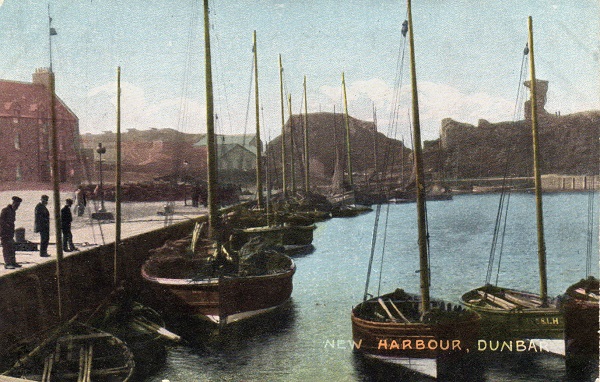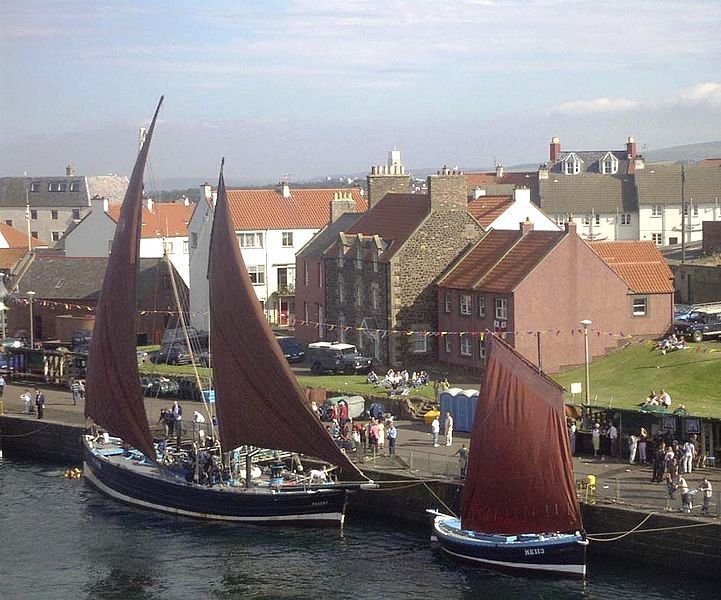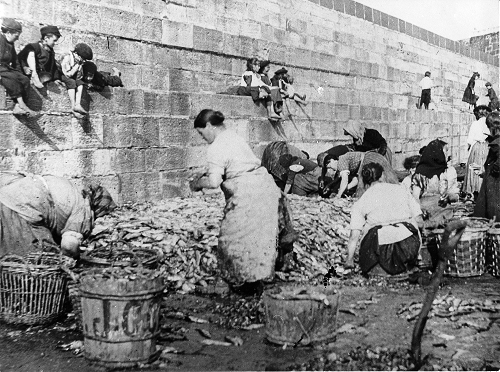Featured in this month’s section are photos taken from the DDHS current exhibition in the Town House – Dunbar, A Safe Haven. This was supposed to open last year but had to be postponed. Fire, siege, occupation, disaster, celebration and working lives are all highlighted in the exhibition. For centuries Dunbar’s coast and harbour area has remained a safe refuge in times of conflict, with a strong community spirit which continues today. Our exhibition looks at just some of the stories, activities and changes, which have taken place there over the years. The exhibition is curated by Pauline Smeed. Additional text is by Pauline Smeed and Jim Herring.
The exhibition is supported with artefacts kindly loaned to us by East Lothian Museums Service, and by local residents. Among them are two medals. The first is the RNLI silver medal, awarded to Coxswain Walter Runciman Fairbairn for gallantry, for the rescue of the crew of the King JaJa, in October 1905. The second medal, the RNLI bronze medal, was awarded to his great grandson, current Coxswain Gary Fairbairn. Again this was for gallantry, for the rescue of two crew members of the yacht Ouhm, in May 2009.
Dunbar, A Safe Haven also complements the Museum Service’s current exhibition running in the Town House Gallery, Brrr, Stories of Dunbar’s Outdoor Swimming Pool. The Town House Museum & Gallery, with covid measures in place, is now open five days a week from Tuesday to Saturday, 1pm-5pm. We are grateful once again to our volunteers who have offered to return to assist in manning our display and to help with queries.
Fishing boats followed the herring shoals and down to the north-east of England. The open-decked Fifies were the most popular fishing boats on the south east coast of Scotland and Glad Tidings is a good example. You can read more about Fifies here (good photos but ignore the apostrophes!). The best known Fifie in relation to Dunbar harbour is The Reaper, which was restored by the Scottish Fisheries Museum (details) and was brought over for people to see. The photo below shows The Reaper in the harbour.
The photo above is looking towards The Hatchery which was just next to the castle. Work began on the Sea Fish Hatchery in the early 1890s. It was an important part of the Fishery Board for Scotland’s research into replenishing sea fish stocks. Harald C Dannevig, a Norwegian expert, was hired to manage the breeding of turbot, sole, plaice and lemon sole on the Dunbar site. You can read more about the hatchery on the John Gray Centre site here. The hatchery was transferred to Aberdeeen after 6 years and became The Aberdeen Marine Laboratory which is still there today as an eminent research centre. Dannevig was recruited by the New South Wales government in Australia and was instrumental in establishing the Australian fishing industry. You read a fascinating article on Dannevig – with good photos – here.
The photo above shows the arduous work done by women, gutting and carefully laying huge amounts of herring in barrels in the early 20th century. In some quarters, the fishwives have been viewed in a romantic way e.g. taking their fish round to the more affluent houses in Dunbar and elsewhere, but the women worked in smelly and often cold conditions with no regard to health and safety. Their hours were long and their wages small. The photo is also interesting for the children sitting on the harbour wall i.e. the women not only did their work with the fish but looked after children as well.
The final photo shows fisherman on the harbourside transferring newly caught herring from a basket into a barrel. The full barrels were then taken to where the fishwives or fisher lassies would gut the herring and repack it into barrels. As you can see in the photo, this was often dirty and smelly work, as well as bring physically arduous. The John Gray Centre has an interesting article (with photos and interviews) on fishing and whaling – see here. You might also want to look at this Scran site about herring fishing in Scotland.






You must be logged in to post a comment.